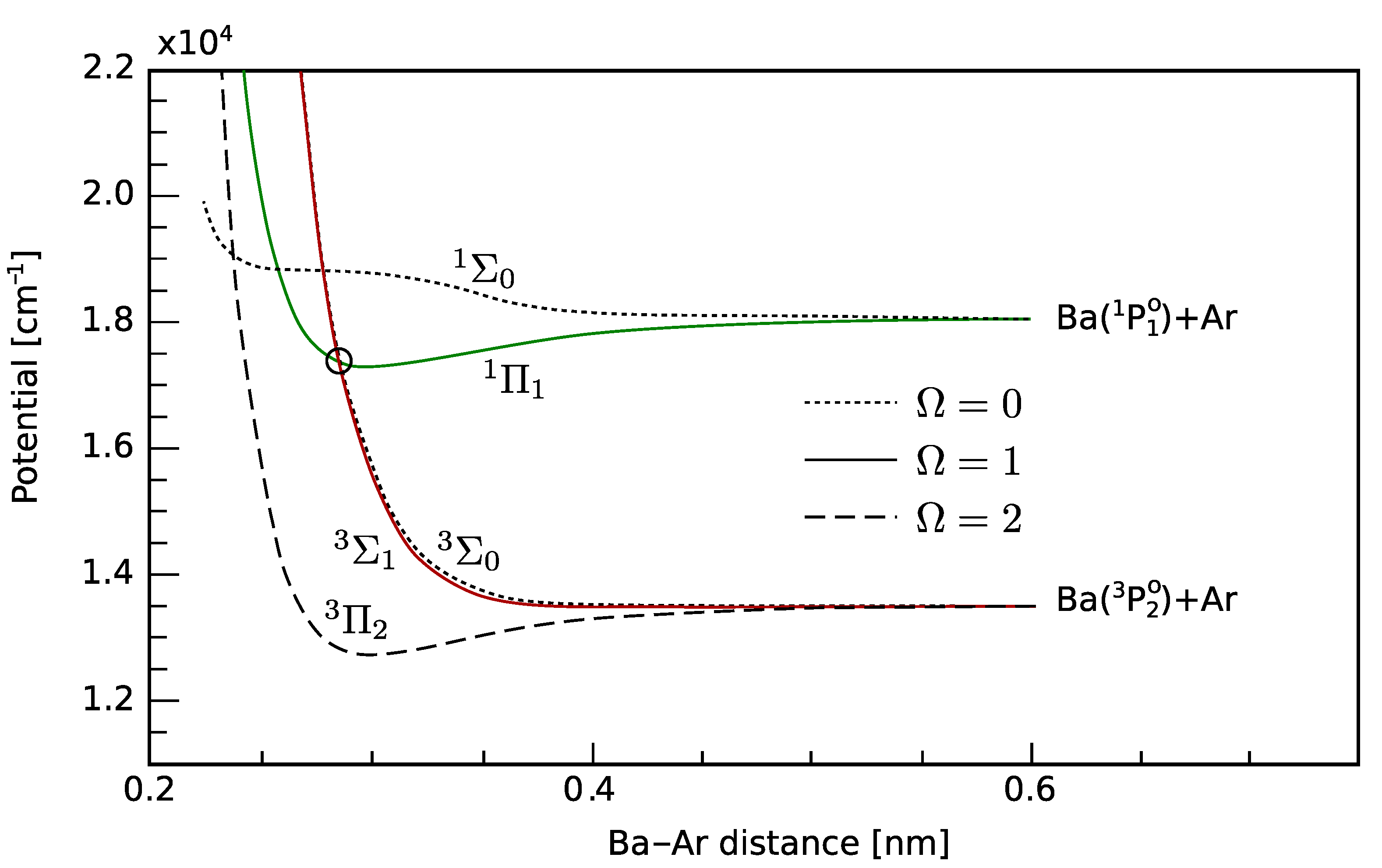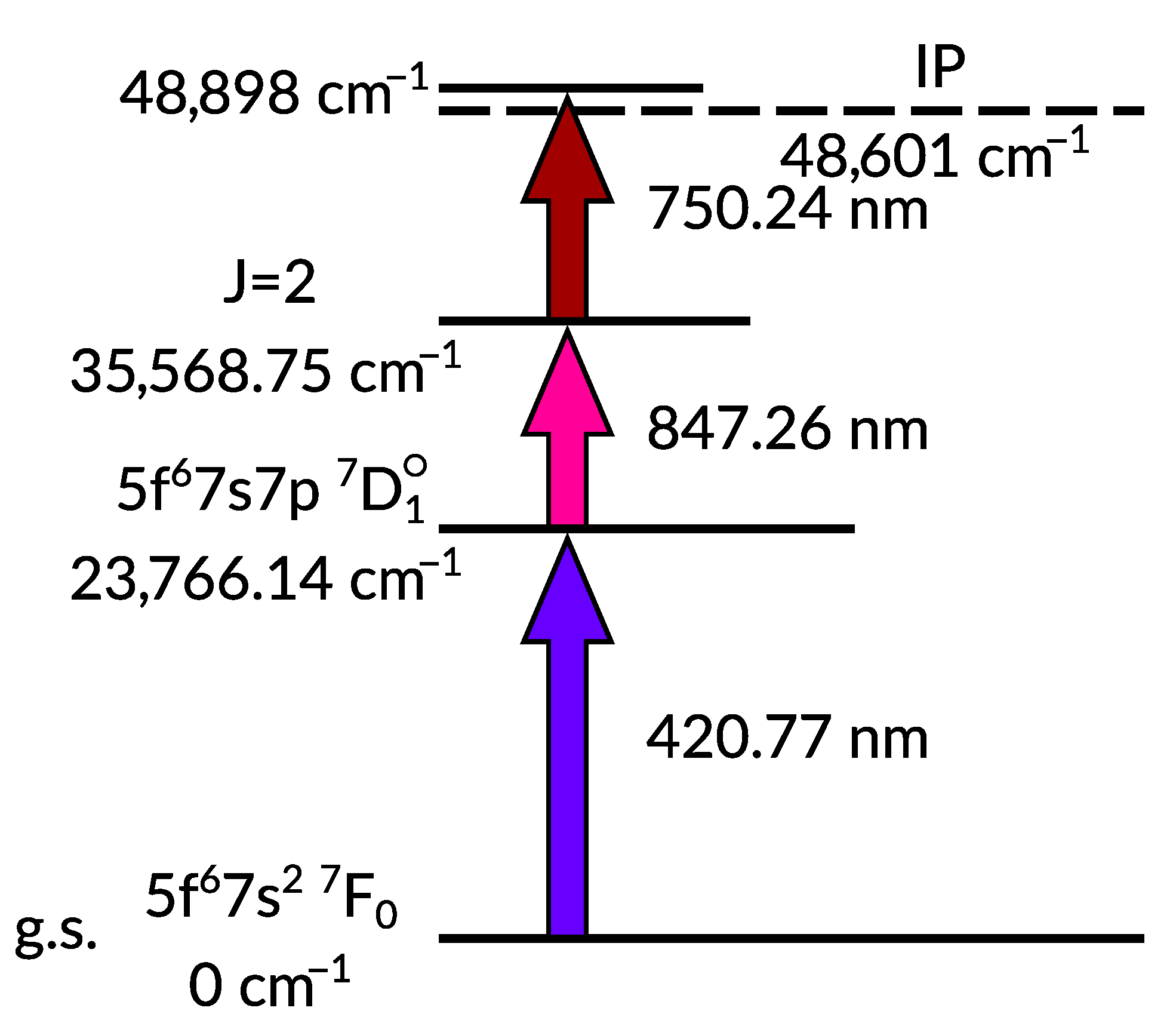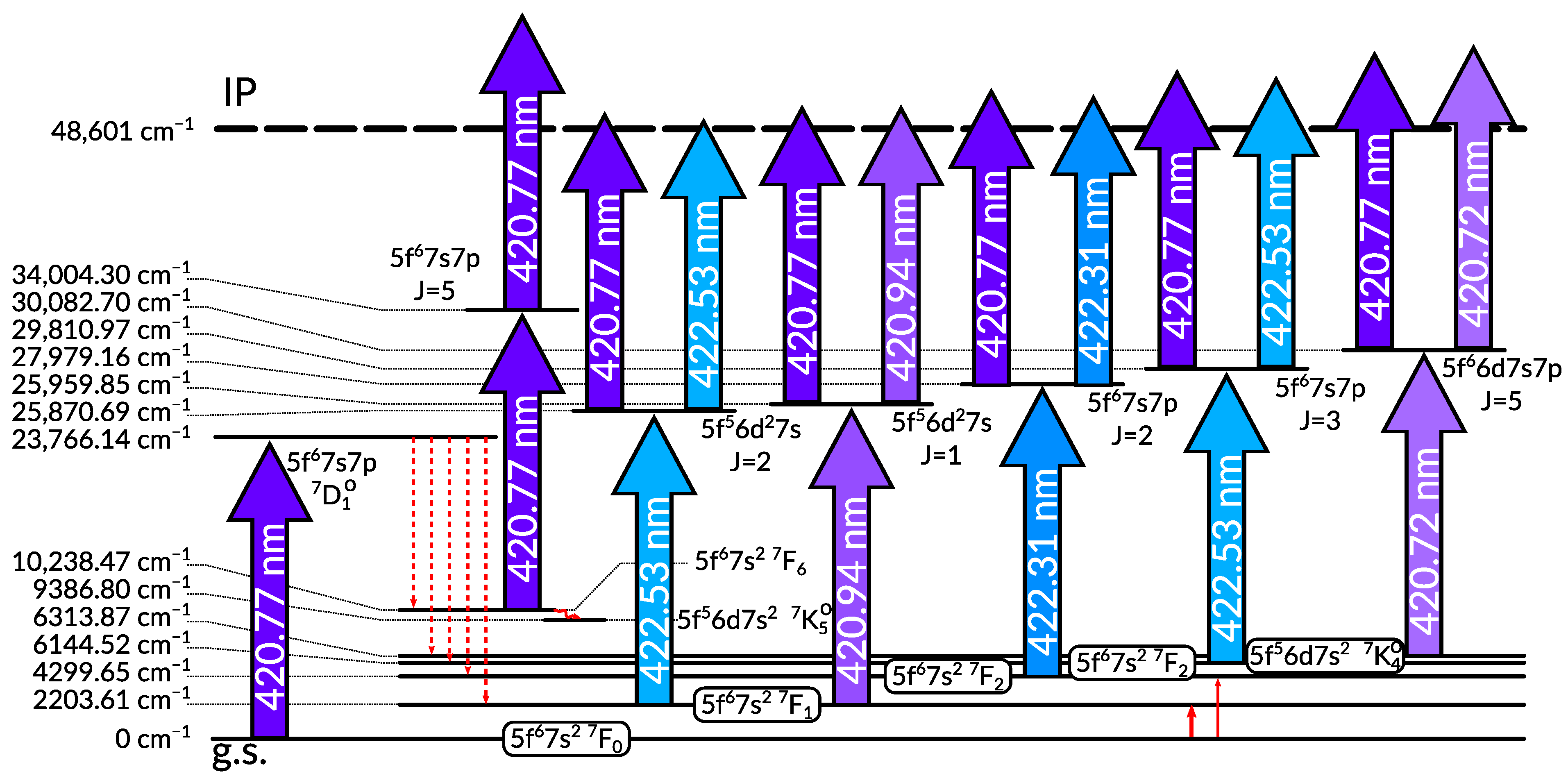Observation of Collisional De-Excitation Phenomena in Plutonium
Abstract
:1. Introduction
Collision-Induced Population Transfer
2. Experimental Method
3. Results and Discussion
4. Outlook
Author Contributions
Funding
Institutional Review Board Statement
Informed Consent Statement
Data Availability Statement
Conflicts of Interest
Abbreviations
| RIB | Radioactive Ion Beam |
| ISOL | Isotope Separator On-Line |
| IGISOL | Ion Guide Isotope Separator On-Line |
| LISOL | Leuven Isotope Separator On-Line |
| SHG | Second Harmonic Generation |
| SPIG | Sextupole Ion Guide |
| MCP | Multichannel Plate |
| FC | Faraday Cup |
| RIS | Resonance Ionization Scheme |
References
- Moore, I.; Dendooven, P.; Ärje, J. The IGISOL technique—three decades of developments. Hyperfine Interact. 2014, 223, 17–62. [Google Scholar] [CrossRef]
- Van Duppen, P.; Bruyneel, B.; Huyse, M.; Kudryavtsev, Y.; Van Den Bergh, P.; Vermeeren, L. Beams of short lived nuclei by selective laser ionization in a gas cell. Hyperfine Interact. 2000, 127, 401–408. [Google Scholar] [CrossRef]
- Hirayama, Y.; Watanabe, Y.; Imai, N.; Ishiyama, H.; Jeong, S.; Jung, H.; Miyatake, H.; Oyaizu, M.; Kimura, S.; Mukai, M.; et al. On-line experimental results of an argon gas cell-based laser ion source (KEK Isotope Separation System). Nucl. Instrum. Methods Phys. Res. Sect. B Beam Interact. Mater. Atoms 2016, 376, 52–56. [Google Scholar] [CrossRef]
- Campbell, P.; Moore, I.; Pearson, M. Laser spectroscopy for nuclear structure physics. Prog. Part. Nucl. Phys. 2016, 86, 127–180. [Google Scholar] [CrossRef]
- Laatiaoui, M.; Lauth, W.; Backe, H.; Block, M.; Ackermann, D.; Cheal, B.; Chhetri, P.; Düllmann, C.E.; Van Duppen, P.; Even, J.; et al. Atom-at-a-time laser resonance ionization spectroscopy of nobelium. Nature 2016, 538, 495–498. [Google Scholar] [CrossRef] [PubMed]
- Edwards, M. The quenching of alkali fluorescence by rare gases. J. Phys. B At. Mol. Phys. 1969, 2, 719. [Google Scholar] [CrossRef]
- Ehrlacher, E.; Huennekens, J. Excitation transfer among, and quenching of, the barium 6s5d 3 D J metastable levels due to collisions with argon, nitrogen, and barium perturbers. Phys. Rev. A 1994, 50, 4786. [Google Scholar] [CrossRef]
- Knoop, M.; Vedel, M.; Vedel, F. Collisional quenching and j-mixing rate constants for the 3 D levels of Ca+. Phys. Rev. A 1998, 58, 264. [Google Scholar] [CrossRef]
- Namiotka, R.; Ehrlacher, E.; Sagle, J.; Brewer, M.; Namiotka, D.; Hickman, A.; Streater, A.; Huennekens, J. Diffusion of barium atoms in the 6s5d 3 D J metastable levels and the 6 s 2 1 S 0 ground state through noble-gas perturbers. Phys. Rev. A 1996, 54, 449. [Google Scholar] [CrossRef]
- Redondo, C.; Rayo, M.S.; Ecija, P.; Husain, D.; Castano, F. Collisional dynamics of low energy states of atomic strontium following the generation of Sr (5s5p1P1) in the presence of Ne, Kr and Xe. Chem. Phys. Lett. 2004, 392, 116–122. [Google Scholar] [CrossRef]
- Church, D.A. Collision measurements and excited-level lifetime measurements on ions stored in Paul, Penning and Kingdon ion traps. Phys. Rep. 1993, 228, 253–358. [Google Scholar] [CrossRef]
- Foo, P.; Wiesenfeld, J.; Husain, D. Collisional quenching of the spin-orbit states of atomic tin, Sn(5p23P2) and Sn(5p23P1). Chem. Phys. Lett. 1975, 32, 443–448. [Google Scholar] [CrossRef]
- Czajkowski, M.; Bobkowski, R.; Krause, L. Depopulation of the 53P1 state of cadmium by collisions with ground-state Cd and noble-gas atoms. Spectrochim. Acta Part B At. Spectrosc. 1991, 46, 1–7. [Google Scholar] [CrossRef]
- Czajkowski, M.; Bobkowski, R.; Krause, L. Depopulation of the Zn 43P1 state by collisions with ground-state Zn and noble-gas atoms. Spectrochim. Acta Part B At. Spectrosc. 1991, 46, 1161–1169. [Google Scholar] [CrossRef]
- Nuñez-Reyes, D.; Kłos, J.; Alexander, M.H.; Dagdigian, P.J.; Hickson, K.M. Experimental and theoretical investigation of the temperature dependent electronic quenching of O (1 D) atoms in collisions with Kr. J. Chem. Phys. 2018, 148, 124311. [Google Scholar] [CrossRef]
- Lara, M.; Berteloite, C.; Paniagua, M.; Dayou, F.; Le Picard, S.D.; Launay, J.M. Experimental and theoretical study of the collisional quenching of S (1 D) by Ar. Phys. Chem. Chem. Phys. 2017, 19, 28555–28571. [Google Scholar] [CrossRef]
- Haberland, H.; Konz, W.; Oesterlin, P. Interaction potentials and energy transfer cross sections for collisions of metastable helium and neon. II. He (21S)+ Ne. J. Phys. B At. Mol. Phys. 1982, 15, 2969. [Google Scholar] [CrossRef]
- Smedley, J.E.; Marran, D.F.; Peabody, M.R.; Marquis, C.N. Electronic energy transfer in Ba 6s8p1P rare gas collisions. J. Chem. Phys. 1993, 98, 1093–1100. [Google Scholar] [CrossRef]
- Breckenridge, W.H.; Merrow, C.N. Exclusive production of Ba (6s6p3P2) in the collisional deactivation of Ba (6s6p1P1 ) by the rare gases. J. Chem. Phys. 1988, 88, 2329–2333. [Google Scholar] [CrossRef]
- Visticot, J.P.; Berlande, J.; Cuvellier, J.; Mestdagh, J.M.; Meynadier, P.; de Pujo, P.; Sublemontier, O.; Bell, A.J.; Frey, J.G. Energy dependence of the inelastic process Ba(6s6p1P1)+Ar,He→Ba(6s6p3P1,2)+Ar,He. J. Chem. Phys. 1990, 93, 5354–5355. [Google Scholar] [CrossRef]
- Visticot, J.P.; De Pujo, P.; Sublemontier, O.; Bell, A.; Berlande, J.; Cuvellier, J.; Gustavsson, T.; Lallement, A.; Mestdagh, J.; Meynadier, P.; et al. Polarization effects in the differential cross section of the Ba (1 P 1- 3 P 2) inelastic transition induced by argon. Phys. Rev. A 1992, 45, 6371. [Google Scholar] [CrossRef] [PubMed]
- Black, G.; Jusinski, L.E. Rate coefficients for S(1D) removal at 300 K. J. Chem. Phys. 1985, 82, 789–793. [Google Scholar] [CrossRef]
- Pohjalainen, I.; Moore, I.; Geldhof, S.; Rosecker, V.; Sterba, J.; Schumm, T. Gas cell studies of thorium using filament dispensers at IGISOL. Nucl. Instrum. Methods Phys. Res. Sect. B Beam Interact. Mater. Atoms 2020, 484, 59–70. [Google Scholar] [CrossRef]
- Kälber, W.; Rink, J.; Bekk, K.; Faubel, W.; Göring, S.; Meisel, G.; Rebel, H.; Thompson, R. Nuclear radii of thorium isotopes from laser spectroscopy of stored ions. Z. Phys. A At. Nucl. 1989, 334, 103–108. [Google Scholar] [CrossRef]
- Kälber, W.; Meisel, G.; Rink, J.; Thompson, R. Two-step optical excitation for doppler linewidth reduction and motion study of ions stored in a paul trap. J. Mod. Opt. 1992, 39, 335–347. [Google Scholar] [CrossRef]
- Chhetri, P.; Ackermann, D.; Backe, H.; Block, M.; Cheal, B.; Düllmann, C.E.; Even, J.; Ferrer, R.; Giacoppo, F.; Götz, S.; et al. Impact of buffer gas quenching on the 1 S 0→ 1 P 1 ground-state atomic transition in nobelium. Eur. Phys. J. D 2017, 71, 1–7. [Google Scholar] [CrossRef]
- Chhetri, P.; Ackermann, D.; Backe, H.; Block, M.; Cheal, B.; Droese, C.; Düllmann, C.E.; Even, J.; Ferrer, R.; Giacoppo, F.; et al. Precision Measurement of the First Ionization Potential of Nobelium. Phys. Rev. Lett. 2018, 120, 263003. [Google Scholar] [CrossRef]
- Pohjalainen, I.; Moore, I.; Kron, T.; Raeder, S.; Sonnenschein, V.; Tomita, H.; Trautmann, N.; Voss, A.; Wendt, K. In-gas-cell laser ionization studies of plutonium isotopes at IGISOL. Nucl. Instrum. Methods Phys. Res. Sect. B Beam Interact. Mater. Atoms 2016, 376, 233–239. [Google Scholar] [CrossRef]
- Reponen, M.; Moore, I.D.; Kessler, T.; Pohjalainen, I.; Rothe, S.; Sonnenschein, V. Laser developments and resonance ionization spectroscopy at IGISOL. Eur. Phys. J. A 2012, 48, 45. [Google Scholar] [CrossRef]
- Tomita, H.; Nakamura, A.; Matsui, D.; Ohtake, R.; Sonnenschein, V.; Saito, K.; Kato, K.; Ohashi, M.; Degner, V.; Wendt, K.; et al. Development of two-color resonance ionization scheme for Th using an automated wide-range tunable Ti: Sapphire laser system. Prog. Nucl. Sci. Technol. 2018, 5, 97–99. [Google Scholar] [CrossRef]
- Karvonen, P.; Moore, I.D.; Sonoda, T.; Kessler, T.; Penttilä, H.; Peräjärvi, K.; Ronkanen, P.; Äystö, J. A sextupole ion beam guide to improve the efficiency and beam quality at IGISOL. Nucl. Instrum. Methods Phys. Res. Sect. B 2008, 266, 4794–4807. [Google Scholar] [CrossRef] [Green Version]
- Voss, A.; Sonnenschein, V.; Campbell, P.; Cheal, B.; Kron, T.; Moore, I.; Pohjalainen, I.; Raeder, S.; Trautmann, N.; Wendt, K. High-resolution laser spectroscopy of long-lived plutonium isotopes. Phys. Rev. A 2017, 95, 032506. [Google Scholar] [CrossRef] [Green Version]
- Raeder, S.; Hakimi, A.; Stöbener, N.; Trautmann, N.; Wendt, K. Detection of plutonium isotopes at lowest quantities using in-source resonance ionization mass spectrometry. Anal. Bioanal. Chem. 2012, 404, 2163–2172. [Google Scholar] [CrossRef] [PubMed]
- Blaise, J.; Fred, M.; Gutmacher, R.G. Term analysis of the spectrum of neutral plutonium, Pu i. JOSA B 1986, 3, 403–418. [Google Scholar] [CrossRef]
- Richards, E.; Ridgeley, A. Preliminary classification in the plutonium I spectrum. Spectrochim. Acta 1965, 21, 1449–1466. [Google Scholar] [CrossRef]
- Granados, C.; Creemers, P.; Ferrer, R.; Gaffney, L.P.; Gins, W.; de Groote, R.; Huyse, M.; Kudryavtsev, Y.; Martínez, Y.; Raeder, S.; et al. In-gas laser ionization and spectroscopy of actinium isotopes near the N=126 closed shell. Phys. Rev. C 2017, 96, 054331. [Google Scholar] [CrossRef] [Green Version]





| (nm) | (nm) | E (cm) | Configuration | Ji | E (cm) | Configuration | Jf |
|---|---|---|---|---|---|---|---|
| 420.72 | 420.712 | 6313.866 | 5f6d7s | 4 | 30,083.102 | - | 5 |
| 420.77 | 420.767 | 0 | 5f7s | 0 | 23,766.139 | 5f7s7p | 1 |
| 420.94 | 420.942 | 2203.606 | 5f7s | 1 | 25,959.849 | 5f6d7s | 1 |
| 422.32 | 422.306 | 4299.659 | 5f7s | 2 | 27,979.161 | 5f7s7p | 2 |
| 422.53 | 422.528 | 2203.606 | 5f7s | 1 | 25,870.685 | 5f6d7s | 2 |
| 422.539 | 6144.515 | 5f7s | 3 | 29,810.974 | 5f7s7p | 3 |
Publisher’s Note: MDPI stays neutral with regard to jurisdictional claims in published maps and institutional affiliations. |
© 2022 by the authors. Licensee MDPI, Basel, Switzerland. This article is an open access article distributed under the terms and conditions of the Creative Commons Attribution (CC BY) license (https://creativecommons.org/licenses/by/4.0/).
Share and Cite
Raggio, A.; Pohjalainen, I.; Moore, I.D. Observation of Collisional De-Excitation Phenomena in Plutonium. Atoms 2022, 10, 40. https://doi.org/10.3390/atoms10020040
Raggio A, Pohjalainen I, Moore ID. Observation of Collisional De-Excitation Phenomena in Plutonium. Atoms. 2022; 10(2):40. https://doi.org/10.3390/atoms10020040
Chicago/Turabian StyleRaggio, Andrea, Ilkka Pohjalainen, and Iain D. Moore. 2022. "Observation of Collisional De-Excitation Phenomena in Plutonium" Atoms 10, no. 2: 40. https://doi.org/10.3390/atoms10020040
APA StyleRaggio, A., Pohjalainen, I., & Moore, I. D. (2022). Observation of Collisional De-Excitation Phenomena in Plutonium. Atoms, 10(2), 40. https://doi.org/10.3390/atoms10020040






